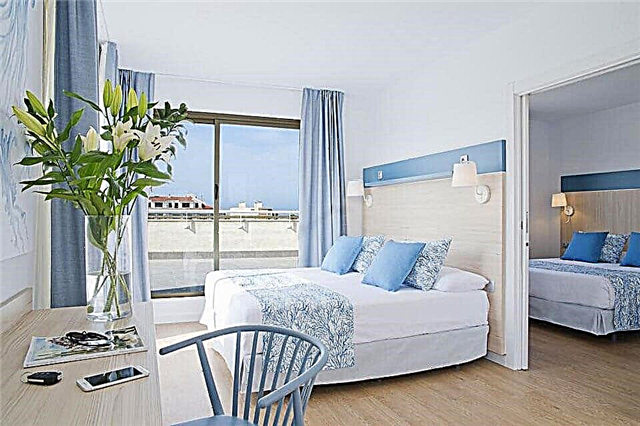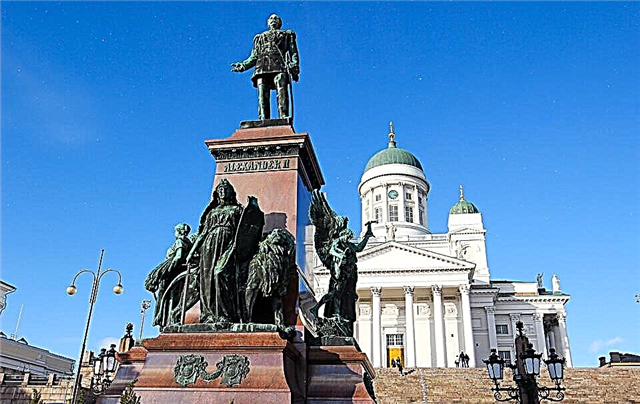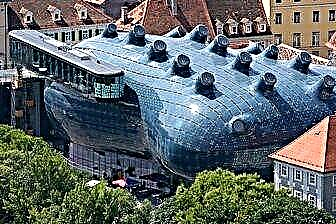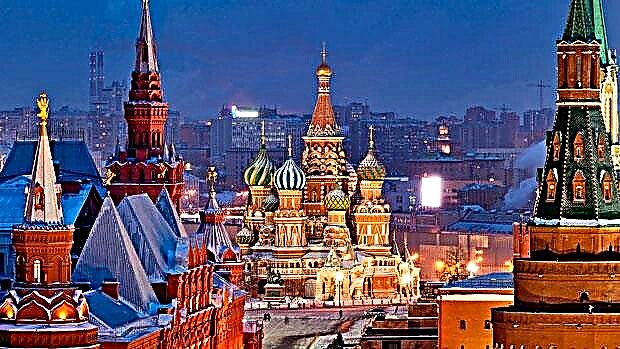It is difficult to find another such country in which all climatic zones from the hot subtropics to the icy Arctic are represented. In terms of the variety of landscapes, Russia is also in the lead among other countries: the mighty taiga, endless steppes, mountain ranges, tropical thickets, seas and lakes - what you just can't see in its vastness. The great history of the multinational country, full of drama and heroism, is reflected in architectural and religious monuments. Unique natural attractions in different parts of Russia amaze with their extraordinary beauty, and man-made ones - with their scale and scope.
Trans-Siberian Railway
The grandiose accomplishment of human hands is the Trans-Siberian Railway (Transsib) - a railway line stretching from the European part of Russia to the Far East (length 9288.2 km). 25 years of inhumanly hard (Sisyphean) labor, mainly of prisoners and local peasants, 1.5 billion. Rubles cost the laying of the Great Siberian Route, the need for which is justified by time. The Transsib connected Europe with Asia in such a way that, for example, from Kaliningrad you can get directly to Vladivostok.
A special attraction of the Transsib is the world's only railway station at the station. Slyudyanka, entirely built of unpolished marble, mined in the Baikal Pereval deposit. This picturesque building with arched windows, domes and spiers, and many marble patterns is a real architectural masterpiece. A unique attraction - so far one of the longest bridges in Russia (2616 m), connecting the banks of the Amur, is named "Amur handsome". The grandiose structure, erected to replace the old bridge in 1992, was awarded the "Gold Medal" (like the Eiffel Tower).

Passenger and freight trains rush along the Trans-Siberian Railway every day. Among them there is a special tourist train "Golden Eagle" from Moscow to Vladivostok, equipped with everything necessary for a comfortable journey across the endless Russian expanses. The train makes stops for excursions to large cities, Buryat auls, along the coast of Lake Baikal - this tour includes the cost of a one-way ticket (on the way - 14 days) and one day of stay at a hotel in Vladivostok. Such a trip will be remembered for a long time by a huge number of the best impressions from everything seen on the Transsib.
Elbrus
Everyone who has read Lermontov's A Hero of Our Time will remember the expressive description of the famous Mount Elbrus, whose snow-white cap is visible from Pyatigorsk in clear weather. How many lyrical and prosaic lines are dedicated to the legendary peak, how many legends about its origin "go", how much beauty the mountain itself and the Elbrus region conceal. There is hardly a climber who would not strive to conquer the mighty peaks of the two-headed extinct volcano. History knows many daredevils from different countries who planted their flag on the highest peak in Europe, more precisely, the peaks: eastern (5623 m) and western (5642 m). Many of them, unfortunately, gave their lives for the sake of extreme climbing.

Mountain surroundings
Elbrus rises above the Baksan gorge of Kabardino-Balkaria, located in the picturesque Baksan valley, named after the river of the same name formed by the Elbrus glaciers. The unearthly beauty of the Elbrus environs opens up to the eyes of travelers driving along the highway along the valley. On both sides one can see the mountain slopes overgrown with forest; winding ribbons of rivers with exotic names are silver among the rocks. The 85th km of the highway is marked by monuments to the first conqueror of the eastern summit of Elbrus, the Kabardian Khashirov (1829) and the pioneer of the western one, the Balkarian Sottaev (1874).

Tourist infrastructure of Elbrus
On the southern slopes of Elbrus, a cable car (height 3750 m) is equipped, intended mainly for skiers and climbers. The complex of 10 insulated trailers and kitchens (the "Bochki" shelter) can simultaneously accommodate 60 people planning to climb up. Above the "Bochek" (3912 m) there is a more comfortable "Liprus" shelter, opened in 2013. Even higher, a new modern building of the Priyut 11 hotel appeared, rebuilt on the site of the burned down one. Additional residential trailers have been installed here, and electricity is supplied with the help of a diesel generator. Another climbing shelter (height 5300 m) is under construction, because every year the interest in the famous peaks does not diminish, but grows.
Valley of geysers in Kamchatka
In the adventure film ballad "Sannikov Land" viewers could see the unique valley of geysers of Kamchatka, where the main episodes of the romantic film were filmed. It was here, in the Kronotsky Nature Reserve, that we managed to photograph the mysterious land described by Academician Obruchev in his story, because the Valley of Geysers is a truly fantastic place. The clouds of steam that cover the slopes above the hot springs, the water gurgling underfoot, the scattering of intricate boulders in the thermal lakes - a truly unearthly landscape.

The Kamchatka geyser valley is the largest natural formation, characterized by a large accumulation of hot springs in one place - the bed of the once dried up river, called the Geysernaya. A specific ecosystem has developed here, in which favorable conditions have been created for the habitation of various representatives of flora and fauna. The first geyser was discovered in 1941 and was named "Firstborn". Now it is hidden under a layer of clay after the catastrophic landslide in 2007, but soon it will wash away the clay and come out.

There are more than 20 geysers in the valley, and each of them has been given a name. The number of sources changes periodically due to geological and climatic changes in the landscape. A landslide in 2007 contributed to the formation of a lake, which absorbed many geysers, and in 2013 not only old springs reopened due to mudflows, but new ones were added. The incredible beauty of the Valley of Geysers attracts tourists more and more, but their stay here is strictly regulated and is under the supervision of specialists due to the danger of scalding with boiling water or other surprises. Experienced guides know all the nuances of a safe journey through the unique valley.
The architectural ensemble of Kizhi
If someone wants to be in the real situation of Ancient Russia, you need to come to about. Kizhi, located in Lake Onega. This reserved corner of Russia, full of the charm of the Russian north, is an open-air museum. Its main exhibits are old churches, a bell tower, chapels and other buildings. A unique architectural ensemble of its kind, consisting of 2 churches and a bell tower, is a wonderful example of wooden architecture of northern Russia.

The Summer Church of the Transfiguration of the Lord is a masterpiece of architecture, a symbol of the highest craftsmanship in wood construction and artistic carving. 22 domes, covered with polished silver aspen plates, crown the church. Each chapter is decorated with chiseled wooden spiers with crosses, the total height of the church is 37 m. The iconostasis of the 18th century is a priceless treasure of spiritual culture.

The Winter Church of the Intercession has 9 chapters with crosses, the 4-main iconostasis is decorated with icons, many of which were created for this temple. The amazing ensemble is complemented by a 30-meter bell tower of the 18th century, harmoniously blended between 2 churches. There is another rarity of ancient wooden architecture on Kizhi - the Church of the Resurrection of Lazarus (13-14 centuries), brought here from the Murom monastery. According to legend, the saint himself cut down this outwardly simple temple.The chapel of the Archangel Michael, a windmill and other wooden buildings evoke respectful tenderness. I would like to wish that these Russian symbols will delight us for a long time.
Kazan Kremlin
The central cultural and historical attraction of Kazan is the Kazan Kremlin, which is a museum-reserve of unique architecture of the 10-13th centuries. The first settlement on the left bank of the river is dated to the 10th century. Kazanka, which for 2 centuries became the Kremlin, a reliable northern outpost of the Volga Bulgaria. After the conquest of Kazan by Ivan the Terrible, wooden buildings were demolished, and mosques were removed. A white-stone Kremlin was built, over the construction of which talented architects from Pskov worked.

Until the end of the 19th century, construction work continued on the territory of the Kremlin: the Governor's Palace, the Junker School, the spiritual consistory, and the bishop's house appeared. The majestic architectural and historical complex is a magnificent sight: high minarets of mosques, round domes of churches, bulk of classical buildings look like a fairy kingdom. Russian and Tatar traditions of architecture and culture are harmoniously intertwined here.
A special attraction of the Kremlin and Kazan is the falling seven-tiered tower of Syusumbike, one of the defensive towers. The Kul-Sharif mosque, the Annunciation Cathedral, the Transfiguration Monastery are very interesting for their architecture. Several historical museums introduce the past and present of Tatarstan. There is also an art museum, a branch of the St. Petersburg Hermitage - "Hermitage Kazan". A visit to the Kazan Kremlin leaves an indelible impression for a lifetime.
Cathedral of st. Sofia in Novgorod
The main attraction of ancient and modern Novgorod is the Cathedral of St. Sofia, built at the beginning of the 11th century. under Prince Vladimir. Knowing how much his father Yaroslav the Wise loved St. Sophia Cathedral in Kiev, Vladimir invited Kiev craftsmen to build a cathedral, similar in architecture to a Kiev temple. The majestic white building is crowned with 5 helmet-shaped domes, 4 of which are gray, and the 5th shines with a golden sheen. Over the centuries of its existence, the cathedral was completed and rebuilt several times, experienced wars and robberies, but survived and now it is an architectural and spiritual symbol of Novgorod.

The cathedral keeps many relics inside and outside. One of them is the Sigtun Gate, brought by the Novgorodians as a war trophy from Sweden. They are cast from metal and represent a unique example of artistic European casting of the 12th century. Scenes from the Old and New Testaments are depicted on bronze plates. Fragments of decorations of the 11-12th century, ancient folios, chronicles and other priceless rarities have been preserved inside the cathedral. The cathedral contains the tombs of its founder - Vladimir, princesses Anna and Alexandra and other noble Novgorodians.
The monumental austere beauty of the greatest religious monument is impressive to the core, making you admire and proud.
Lake Baikal
In Eastern Siberia, there is a unique ancient reservoir - the deepest lake Baikal in the world (1637 m). It can be called a true natural treasure, containing 19% of the world's purest fresh water, a large amount of fish. Everyone knows the famous Baikal omul, which lives only in this lake. The world of flora and fauna along the shores of Lake Baikal is also rich and diverse, the territory of which is actively explored by scientists and travelers. Considering that the water area of Lake Baikal is located at an altitude of about 500 m above sea level, then it can be considered a mountain lake formed millions of years ago as a result of the movement of tectonic plates.

27 picturesque islands adorn the water surface of Lake Baikal, each of which is unique in its own way. The Baikal water is so transparent that you can see the stone bottom at a depth of 40 meters. Baikal enchants with its unique beauty at any time of the year. To visit the greatest lake in the world is a great happiness.
Moscow Kremlin
The majestic architectural complex - the heart of Moscow and Russia - the Kremlin was first mentioned in the annals of 1156, when at the mouth of the river. Neglinnaya began to build wooden fencing walls for the future fortress, later burnt down by the Mongol-Tatars. The modern Kremlin, as everyone sees it now, is the merit of all Russian rulers, from Dmitry Donskoy to the heads of the Soviet state. The architectural ensemble of the Moscow Kremlin includes a fortress with mighty walls and towers (20), cathedrals (10), chambers, palaces, administrative buildings, 4 squares and 3 streets.

The entire history of the Russian state is reflected in majestic buildings of irresistible beauty; the dazzling luxury of the decoration of cathedrals, palaces and chambers is evidence of the power and wealth of a huge state. The Grand Kremlin Palace, the Faceted and the Armory Chambers amaze with their magnificent interiors and luxurious furnishings. Each cathedral in the Kremlin is a truly fabulous structure, embodying high spirituality, vivid beauty and immense talent of its creators. St. Basil's Cathedral with 10 chapters is a unique example of an Orthodox church, familiar to everyone from the numerous pictures on the covers of textbooks, magazines and calendars. A lot of the best impressions await those who first see with their own eyes all the beauties of the Moscow Kremlin.
Hermitage
The national pride of Russians is the Hermitage temple of works of art, whose exhibits are housed in 6 buildings, originated from the private collection of the enlightened monarch Catherine II, who acquired 220 paintings by famous masters. The new collection was placed in the distant palace halls, called the "Hermitage" (French secluded place). Each subsequent sovereign considered it an honor to replenish the collection of paintings, sculptures, objects of applied art, archaeological relics, and as a result there were such a number that they occupied a whole complex of buildings (6). To at least 1-2 min. pay to each exhibit (there are almost 3 million of them), you need to come here every day throughout the year.

Everything here is impressive: luxurious facades of buildings, splendor of decoration, unsurpassed masterpieces of painting and sculpture, including the works of L. Da Vinci, Titian, Rembrandt, Ivanov, Repin, Levitan. It is easier to name the creators whose works are not here - this is the wide range of names of famous masters. The Hermitage is the main object of visit for everyone who comes to St. Petersburg.
St Basil's Church
Among the world's masterpieces of architecture, St. Basil's Cathedral occupies not the last place, being the personification of the beauty of the mysterious Russian soul, the faith of the Russian people in a bright future. Without this, it was impossible to create such an architectural perfection, amazing in its bright beauty and graceful filigree of all elements. Looking at the cathedral, it is hard to believe that this is the work of human hands: it seems that it arose by fabulous magic. A temple was built in honor of the holy Moscow miracle worker Blessed Basil, the holy fool seer.

Each of the 10 chapters of the stone tent-roofed temple has its own uniquely beautiful view, its own individuality, expressed in chiseled patterns and a rainbow spectrum of colors. How talented were the Russian Michelangelo and Raphael, who erected one of the main monuments not only in Moscow, but throughout Russia! It is not known exactly who built the cathedral, symbolizing Heavenly Jerusalem: according to one version, these were Russian architects Barma and Postnik, according to the other - a Western European architect. Honor and praise to the creators of this unsurpassed architectural masterpiece of spiritual culture.
Red Square
Another main symbol of Russia, along with the Kremlin, which is close and dear to every citizen of the country, is Red Square.All the most important events in the life of the state and the people take place on the legendary paving stones: privates and generals are minting a step, the power of military equipment is demonstrated at the Victory Parade; there are shows and gala concerts, performances by world and domestic stars. Every day here you can see foreigners amazed by the beauty of the surrounding architecture.

The date of the formation of the square is considered to be 1493, when the wooden buildings located here were destroyed by another fire. It was decided not to build up this place anymore. The resulting square was called "Fire", but after the magnificent buildings that arose around the square and the design of the square with paving stones, they began to call it "Red" from the Old Russian "beautiful". This name precisely defined the essence of the main square of the country.
There is something to see here: the majestic cathedrals of the Assumption, Basil the Blessed and Kazan, the famous Spasskaya tower with chimes, the Resurrection gate, the chapel of the Iberian icon, the grandiose building of GUM. A historical landmark is the notorious Lobnoye Place, where the imperial decrees were obeyed and the condemned were deprived of their heads. The most revered cult object of the Soviet era is the Mausoleum, where many kilometers of queues were lined up. The expressive monument to the Russian heroes Minin and Pozharsky and the State Historical Museum are of great interest.
Altai mountains
An extensive system of mountain ranges, located in 4 countries, covers part of Russian Siberia between Novosibirsk and Kemerovo. "Russian Alps" - this is how the Altai mountains of Russia are sometimes called, conquering with their immense grandeur and incredible beauty. Amazing landscapes with crystal lakes, sparkling waterfalls, rushing rivers, mighty spruce forests, pine forests and captivating alpine meadows are enchantingly beautiful. The extraordinary generosity of the nature of the Altai Mountains amazes and conquers; it is not for nothing that so many talented people were born on this earth.

UNESCO World Heritage Sites - Lake Teletskoye, Belukha, Ukok Plateau, Altai and Katunsky Reserves, united into the Altai - Golden Mountains complex. The richest flora and fauna of the region, picturesque Karakol lakes, many mysterious caves, pagan idols of Shavlin, unique rivers attract more and more tourists and fans of extreme travel. No need to travel to Canada or America to see the true beauty of the mountains; it is enough to come to Altai.
State Tretyakov Gallery
The Tretyakov Gallery, the largest art museum in the country, was founded by the outstanding philanthropist, merchant P.M. Tretyakov, an invaluable heritage of Russia, a real treasure trove of works of art by Russian painters. This progressive person and patriot can serve as a vivid example of serving the homeland to today's oligarchs, who care more about acquiring personal yachts, airplanes and foreign villas. Everyone who visits the gallery takes away a piece of gratitude for the opportunity to see the amazing masterpieces of painting, sculpture, icon painting and graphics (over 100 thousand).

Every year the gallery's collection is replenished with new works by contemporary Russian masters. Now the exhibits of the Tretyakov Gallery are located in 3 buildings (2 - in Lavrushinsky Lane and 1 - on Krymsky Val). Masses of people “flow” to them in a continuous stream, wishing to enjoy the spectacle of the best examples of the fine art of Vereshchagin, Repin, Vasiliev, Fedotov, Levitan, Serov, Kustodiev, Polenov and many other brilliant creators of Russia.
Peterhof
The modern controversy surrounding the erected monument to Ivan the Terrible in Orel also affects the reformer Tsar Peter I, who carried out reforms "on bones and blood." But when, sailing on a boat to Peterhof at 11.00, you see the unearthly beauty of the architectural and landscape pearl of Russia in the glitter of fountain splashes, you mentally sing praises to the great Pyotr Alekseevich. And after walking through his imperial country residence, seeing the irresistibly beautiful appearance of the "Russian Versailles", you remain conquered forever by the power of the mind and talent of the Russian innovator tsar and justify all manifestations of cruelty.

But you feel even greater gratitude to those who managed to restore the sights barbarously destroyed by the war, to return them to their original appearance. The magnificent beauty of palaces, gilded statues, pavilions, fountains (150), parks, inherited by Russia, surpasses the beauty of the residences of France and England. The Grand Palace, Monplaisir, Marly, the Hermitage Pavilion are unsurpassed architectural masterpieces, the highest examples of aesthetic interior design. Each of the fountains is a miracle of fountain engineering and artistic design. Delightful landscaping of parks, flower beds and lawns. Having once visited this fabulous place called Peterhof, you will fall in love with it for the rest of your life!
Mamaev Kurgan and sculpture "Motherland Calls"
The memorial complex, one of the "Seven Wonders of Russia", whose creation was scheduled back in 1944, is dedicated to 2 million defenders of Stalingrad, who died in the bloodiest and most terrible battle, when the earth was burning underfoot. The outstanding Russian sculptor Vuchetich created sculptures and monuments that are unique in their artistic expression and power. Many of them cannot be looked at without tears - so capaciously and accurately they convey the exorbitant weight of the heroic defense of the city, evoking feelings of immense sorrow and gratitude to the courageous heroes.

The memorial is located on the site of the fiercest battles, at the strategic "height 102" and occupies 26 hectares, beginning with the sculptural composition "Memory of Generations": figures of people of different ages carved in stone go to bow to the ashes of the dead. The names of Russian hero cities are engraved on the granite slabs. Above - the square "Standing to Death", where among the pool, like an epic hero, a granite warrior with a grenade and a machine gun rises - a symbol of courage and valor.
It is impossible to look at the ruined walls without a spiritual shudder, the high reliefs of which depict the horrors of battles. The mournful impression is complemented by the sound design: the crackle of machine guns, the roar of fighters, information reports. The "Hall of Sorrow", where Schumann's "Dreams" are performed, can be called the "Hall of Wailing" - the atmosphere created there is so touchingly sad. The same impression is produced when visiting the "Square of Sorrow" with the Grieving mother mourning her lost son.

The crown of the memorial is the famous sculpture of the Motherland, in a fluttering dress, with a sword in his raised hand, personifying the call for the destruction of the invaders. The majestic figure of the Mother is installed on a pedestal, fixed on a 16-meter deep foundation, the total height of the monument is 86 m, weight is more than 8000 tons. The sculpture is supported in an upright position by 99 cables weighing 66 tons each. The 14-ton sword, made of durable steel, is drilled with windproof holes. Thousands of people come here every day to bow, pay tribute to the 35 thousand soldiers who fell at this height and all those who died defending the Volga stronghold - Stalingrad.
Weathering pillars in Komi
Another of the “seven wonders of Russia, already natural, is located on the Small Mountain of Idols (Man-Pupu-ner) in Komi. These are bizarre pillars of weathering (Mansi blockheads) - unique geological remnants from the once high mountains that existed here 200 million ago. Past epochs, natural forces of wind, frost, precipitation destroyed softer rocks, leaving only memories of the mountains in the form of amazing pillars of different heights and shapes. There are only 7 of them, the height ranges from 30 to 42 m. For many centuries, they were a cult place for the ancient Mansi, who worshiped stone statues and told legends about them.

Only well-trained tourists can approach them, because the "stone statues" are located far from residential areas. In winter, the outliers, shrouded in sparkling snow, look like fabulous creatures, and in foggy weather they look like ghostly giants.











